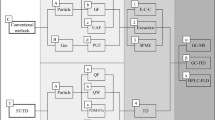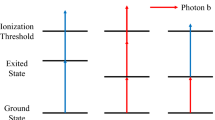Abstract
In the last decade, the development of novel analytical methodologies enabled the identification of several environmental pollutants responsible for health problems associated with indoor exposure. Polycyclic aromatic hydrocarbons (PAHs) are among the potential hazardous chemicals present in ambient air. Due to their bioaccumulation potential and carcinogenic/mutagenic effects, 16 PAHs are currently listed as priority air pollutants. The main goal of this work was to implement a new and simple method for sampling and determination of PAHs in air by using a thermal desorption (TD) technique followed by gas chromatography coupled with mass spectrometry analysis. A detailed study was carried out to optimise the experimental method in each of its phases, including (active) sampling, TD and chromatographic analysis. The results demonstrate that this approach allowed the detection and quantification of the six more volatile PAHs, namely, naphthalene, acenaphthylene, acenaphthene, fluorene, phenanthrene, and anthracene. Acceptable precision and good linearity over the explored range were obtained. No carry-over was observed during experimental tests and the method provided a reproducible answer. The applicability of the novel methodology was tested in real environment, namely, on the roof of a building in an urban area, in a domestic kitchen and in a collective car garage. The method enabled the identification of two PAHs in the field samples, specifically, naphthalene (two rings) and phenanthrene (three rings). With regard to PAHs sample composition, the most abundant PAH found, in the three different locations, was naphthalene, accounting for about 84–100 % of the total PAH mass detected.



Similar content being viewed by others
Abbreviations
- GC-MS:
-
Gas chromatography coupled with mass spectrometry
- HPLC:
-
High performance liquid chromatography
- IAQ:
-
Indoor air quality
- PAH:
-
Polycyclic aromatic hydrocarbon
- RSD:
-
Relative standard deviation
- SIM:
-
Single ion monitoring
- SVOC:
-
Semi-volatile organic compound
- TD:
-
Thermal desorption
- US EPA:
-
US Environmental Protection Agency
- VOC:
-
Volatile organic compound
- WHO:
-
World Health Organisation
References
Aragon, P., Atienza, J., & Climent, M. D. (2000). Analysis of organic compounds in air: a review. Critical Reviews in Analytical Chemistry, 30(2–3), 121–151.
Baltussen, E., Janssen, H. G., Sandra, P., & Cramers, C. A. (1997). A new method for sorptive enrichment of gaseous samples: application in air analysis and natural gas characterization. Journal of High Resolution Chromatography, 20(7), 385–393.
Baltussen, E., David, F., Sandra, P., Janssen, H. G., & Cramers, C. A. (1998). Sorption tubes packed with polydimethylsiloxane: a new and promising technique for the preconcentration of volatiles and semi-volatiles from air and gaseous samples. Journal of High Resolution Chromatography, 21(6), 332–340.
Baltussen, E., Cramers, C. A., & Sandra, P. J. F. (2002). Sorptive sample preparation—A review. Analytical and Bioanalytical Chemistry, 373(1–2), 3–22. doi:10.1007/s00216-002-1266-2.
Bates, M., Bruno, P., Caputi, M., Caselli, M., de Gennaro, G., & Tutino, M. (2008). Analysis of polycyclic aromatic hydrocarbons (PAHs) in airborne particles by direct sample introduction thermal desorption GC/MS. Atmospheric Environment, 42(24), 6144–6151. doi:10.1016/j.atmosenv.2008.03.050.
Bello, A., Quinn, M. M., Perry, M. J., & Milton, D. K. (2010). Quantitative assessment of airborne exposures generated during common cleaning tasks: a pilot study. Environmental Health, 9. doi:7610.1186/1476-069x-9-76.
Bidleman, T. F., Billings, W. N., & Foreman, W. T. (1986). Vapor particle partitioning of semivolatile organic-compounds—estimates from field collections. Environmental Science & Technology, 20(10), 1038–1043. doi:10.1021/es00152a013.
Borras, E., Tortajada-Genaro, L. A., Vazquez, M., & Zielinska, B. (2009). Polycyclic aromatic hydrocarbon exhaust emissions from different reformulated diesel fuels and engine operating conditions. Atmospheric Environment, 43(37), 5944–5952. doi:10.1016/j.atmosenv.2009.08.010.
Chiang, P. C., Chiang, Y. C., Chang, E. E., & Chang, S. C. (2003). Characteristics of polynuclear aromatic hydrocarbons in ambient air through a long-term sampling program at a metropolitan city in Taiwan. Aerosol Science and Technology, 37(2), 133–144. doi:10.1080/02786820390112579.
Chuang, J. C., Cao, S. R., Xian, Y. L., Harris, D. B., & Mumford, J. L. (1992). Chemical characterization of indoor air of homes from communes in Xuan-Wei, China, with high lung-cancer mortality-rate. Atmospheric Environment Part a-General Topics, 26(12), 2193–2201. doi:10.1016/0960-1686(92)90408-d.
Delgado-Saborit, J. M., Aquilina, N., Baker, S., Harrad, S., Meddings, C., & Harrison, R. M. (2010). Determination of atmospheric particulate-phase polycyclic aromatic hydrocarbons from low volume air samples. Analytical Methods, 2(3), 231–242. doi:10.1039/b9ay00157c.
Delgado-Saborit, J. M., Stark, C., & Harrison, R. M. (2011). Carcinogenic potential, levels and sources of polycyclic aromatic hydrocarbon mixtures in indoor and outdoor environments and their implications for air quality standards. Environment International, 37(2), 383–392. doi:10.1016/j.envint.2010.10.011.
Eiguren-Fernandez, A., Avol, E. L., Thurairatnam, S., Hakami, M., Froines, J. R., & Miguel, A. H. (2007). Seasonal influence on vapor- and particle-phase polycyclic aromatic hydrocarbon concentrations in school communities located in Southern California. Aerosol Science and Technology, 41(4), 438–446. doi:10.1080/02786820701213511.
Fernandez-Villarrenaga, V., Lopez-Mahia, P., Muniategui-Lorenzo, S., Prada-Rodriguez, D., Fernandez-Fernandez, E., & Tomas, X. (2004). C1 to C9 volatile organic compound measurements in urban air. Science of the Total Environment, 334, 167–176. doi:10.1016/j.scitotenv.2004.04.037.
Fraga, S., Ramos, E., Martins, A., Samudio, M. J., Silva, G., Guedes, J., et al. (2008). Indoor air quality and respiratory symptoms in Porto schools. Revista Portuguesa De Pneumologia, 14(4), 487–507.
Gustafson, P., Ostman, C., & Sallsten, G. (2008). Indoor levels of polycyclic aromatic hydrocarbons in homes with or without wood burning for heating. Environmental Science & Technology, 42(14), 5074–5080. doi:10.1021/es800304y.
Helmig, D. (1999). Air analysis by gas chromatography. Journal of Chromatography. A, 843(1–2), 129–146. doi:10.1016/s0021-9673(99)00173-9.
Ho, S. S. H., & Yu, J. Z. (2004). In-injection port thermal desorption and subsequent gas chromatography–mass spectrometric analysis of polycyclic aromatic hydrocarbons and n-alkanes in atmospheric aerosol samples. Journal of Chromatography. A, 1059(1–2), 121–129. doi:10.1016/j.chroma.2004.10.013.
IARC. (2002). Naphthalene. IARC Monographs on the Evaluation of Carcinogenic Risks to Humans (Vol. 82). Lyon: World Health Organization International Agency for Research on Cancer.
Jia, C. R., & Batterman, S. (2010). A Critical review of naphthalene sources and exposures relevant to indoor and outdoor air. International Journal of Environmental Research and Public Health, 7(7), 2903–2939. doi:10.3390/ijerph7072903.
JRC/IHCP/PCE. (2005). Critical appraisal of the setting and implementation of indoor exposure limits in the EU. The INDEX project. Final report. Ispra: European Commission, Joint Research Centre, Institute for Health and Consumer Protection, Physical and Chemical Exposure Unit.
Kalf, D. F., Crommentuijn, T., & vande Plassche, E. J. (1997). Environmental quality objectives for 10 polycyclic aromatic hydrocarbons (PAHs). Ecotoxicology and Environmental Safety, 36(1), 89–97. doi:10.1006/eesa.1996.1495.
Koistinen, K., Kotzias, D., Kephalopoulos, S., Schlitt, C., Carrer, P., Jantunen, M., et al. (2008). The INDEX project: executive summary of a European Union project on indoor air pollutants. Allergy, 63(7), 810–819. doi:10.1111/j.1398-9995.2008.01740.x.
Lee, W. J., Wang, Y. F., Lin, T. C., Chen, Y. Y., Lin, W. C., Ku, C. C., et al. (1995). PAH characteristics in the ambient air of traffic-source. Science of the Total Environment, 159(2–3), 185–200. doi:10.1016/0048-9697(95)04323-s.
Leotz-Gartziandia, E., Tatry, V., & Carlier, P. (2000). Sampling and analysis of polycyclic aromatic hydrocarbons (PAH) and oxygenated PAH in diesel exhaust and ambient air. Polycyclic Aromatic Compounds, 20(1–4), 245–258. doi:10.1080/10406630008034789.
Li, & Ro, Y. S. (2000). Indoor characteristics of polycyclic aromatic hydrocarbons in the urban atmosphere of Taipei. Atmospheric Environment, 34(4), 611–620. doi:10.1016/s1352-2310(99)00171-5.
Li, Schoonover, T. M., Zou, Q. M., Norlock, F., Conroy, L. M., Scheff, P. A., et al. (2005). Polycyclic aromatic hydrocarbons in residential air of ten Chicago area homes: concentrations and influencing factors. Atmospheric Environment, 39(19), 3491–3501. doi:10.1016/j.atmosenv.2005.02.029.
Liu, Y. J., Zhu, L. Z., & Shen, X. Y. (2001). Polycyclic aromatic hydrocarbons (PAHs) in indoor and outdoor air of Hangzhou, China. Environmental Science & Technology, 35(5), 840–844. doi:10.1021/es001354t.
Lu, H., Zhu, L. Z., & Chen, S. G. (2008). Pollution level, phase distribution and health risk of polycyclic aromatic hydrocarbons in indoor air at public places of Hangzhou, China. Environmental Pollution, 152(3), 569–575. doi:10.1016/j.cnvpol.2007.07.005.
Mastral, A. M., & Callen, M. S. (2000). A review an polycyclic aromatic hydrocarbon (PAH) emissions from energy generation. Environmental Science & Technology, 34(15), 3051–3057. doi:10.1021/es001028d.
Ohura, T., Amagai, T., Fusaya, M., & Matsushita, H. (2004). Polycyclic aromatic hydrocarbons in indoor and outdoor environments and factors affecting their concentrations. Environmental Science & Technology, 38(1), 77–83. doi:10.1021/es030512o.
Ono-Ogasawara, M., Myojo, T., & Smith, T. J. (2008). A simple direct injection method for GC/MS analysis of PAHs in particulate matter. Industrial Health, 46(6), 582–593.
Possanzini, M., Di Palo, V., Gigliucci, P., Concetta, M., Sciano, T., & Cecinato, A. (2004). Determination of phase-distributed PAH in Rome ambient air by denuder/GC-MS method. Atmospheric Environment, 38(12), 1727–1734. doi:10.1016/j.atmosenv.2003.12.024.
Preuss, R., Angerer, J., & Drexler, H. (2003). Naphthalene—an environmental and occupational toxicant. International Archives of Occupational and Environmental Health, 76(8), 556–576. doi:10.1007/s00420-003-0458-1.
Sanderson, E. G., & Farant, J. P. (2004). Indoor and outdoor polycyclic aromatic hydrocarbons in residences surrounding a Soderberg aluminum smelter in Canada. Environmental Science & Technology, 38(20), 5350–5356. doi:10.1021/es030715c.
Slezakova, K., Castro, D., Begonha, A., Delerue-Matos, C., Alvim-Ferraz, M. D., Morais, S., et al. (2011). Air pollution from traffic emissions in Oporto, Portugal: health and environmental implications. Microchemical Journal, 99(1), 51–59. doi:10.1016/j.microc.2011.03.010.
Tao, S., Liu, Y. N., Xu, W., Lang, C., Liu, S. Z., Dou, H., et al. (2007). Calibration of a passive sampler for both gaseous and particulate phase polycyclic aromatic hydrocarbons. Environmental Science & Technology, 41(2), 568–573. doi:10.1021/es061786.
US EPA (1998). Handbook for air toxics emission inventory development: Stationary Sources. Environmental Protection Agency, Office of Air Quality Planning and Standards: United States (Vol. 1).
Van Winkle, M. R., & Scheff, P. A. (2001). Volatile organic compounds, polycyclic aromatic hydrocarbons and elements in the air of ten urban homes. Indoor Air: International Journal of Indoor Air Quality and Climate, 11(1), 49–64. doi:10.1034/j.1600-0668.2001.011001049.x.
Viau, C., Hakizimana, G., & Bouchard, M. (2000). Indoor exposure to polycyclic aromatic hydrocarbons and carbon monoxide in traditional houses in Burundi. International Archives of Occupational and Environmental Health, 73(5), 331–338. doi:10.1007/s004209900112.
Wauters, E., Van Caeter, P., Desmet, G., David, F., Devos, C., & Sandra, P. (2008). Improved accuracy in the determination of polycyclic aromatic hydrocarbons in air using 24 h sampling on a mixed bed followed by thermal desorption capillary gas chromatography–mass spectrometry. Journal of Chromatography. A, 1190(1–2), 286–293. doi:10.1016/j.chroma.2008.02.081.
Whitehead, T., Metayer, C., Gunier, R. B., Ward, M. H., Nishioka, M. G., Buffler, P., et al. (2011). Determinants of polycyclic aromatic hydrocarbon levels in house dust. Journal of Exposure Science and Environmental Epidemiology, 21(2), 123–132. doi:10.1038/jes.2009.68.
WHO. (1987). IARC Monographs on the Evaluation of Carcinogenic Risks to Humans. (Vol. 6). Lyon: World Health Institution.
WHO (2000). Air quality guidelines for Europe. World Health Organization regional publications. European series (pp. V–X, 1–273).
WHO (2006). Development of WHO Guidelines for Indoor Air Quality. World Health Organization Regional Office for Europe. Boon.
WHO (2010). WHO guidelines for indoor air quality: selected pollutants. World Health Organization Regional Office for Europe. Bonn.
Wilson, N. K., Kuhlman, M. R., Chuang, J. C., Mack, G. A., & Howes, J. E. (1989). A quiet sampleler for the collection of semivolatile organic pollutants in indoor air. Environmental Science & Technology, 23(9), 1112–1116. doi:10.1021/es00067a008.
Yang, M. H., Kim, S. Y., Lee, E., Cheong, H. K., Chang, S. S., Kang, D. H., et al. (2003). Sources of polycyclic aromatic hydrocarbon exposure in non-occupationally exposed Koreans. Environmental and Molecular Mutagenesis, 42(4), 250–257. doi:10.1002/em.10196.
Zhu, L. Z., & Wang, J. (2003). Sources and patterns of polycyclic aromatic hydrocarbons pollution in kitchen air, China. Chemosphere, 50(5), 611–618. doi:10.1016/s0045-6535(02)00668-9.
Author information
Authors and Affiliations
Corresponding author
Rights and permissions
About this article
Cite this article
Martins, G.V., Martins, S., Martins, A.O. et al. Determination of gaseous polycyclic aromatic hydrocarbons by a simple direct method using thermal desorption–gas chromatography–mass spectrometry. Environ Monit Assess 185, 6447–6457 (2013). https://doi.org/10.1007/s10661-012-3036-8
Received:
Accepted:
Published:
Issue Date:
DOI: https://doi.org/10.1007/s10661-012-3036-8




